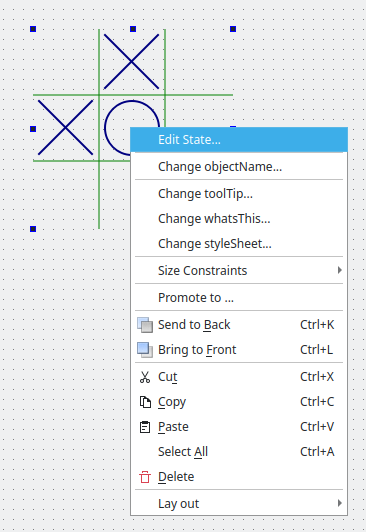PySide6.QtDesigner.QDesignerTaskMenuExtension¶
- class QDesignerTaskMenuExtension¶
The
QDesignerTaskMenuExtensionclass allows you to add custom menu entries to Qt Widgets Designer’s task menu.Details
Warning
This section contains snippets that were automatically translated from C++ to Python and may contain errors.
QDesignerTaskMenuExtensionprovides an interface for creating custom task menu extensions. It is typically used to create task menu entries that are specific to a plugin in Qt Widgets Designer.Qt Widgets Designer uses the
QDesignerTaskMenuExtensionto feed its task menu. Whenever a task menu is requested, Qt Widgets Designer will query for the selected widget’s task menu extension.
A task menu extension is a collection of QActions. The actions appear as entries in the task menu when the plugin with the specified extension is selected. The image above shows the custom Edit State… action which appears in addition to Qt Widgets Designer’s default task menu entries: Cut, Copy, Paste etc.
To create a custom task menu extension, your extension class must inherit from both QObject and
QDesignerTaskMenuExtension. For example:class MyTaskMenuExtension(QObject, public QDesignerTaskMenuExtension Q_OBJECT Q_INTERFACES(QDesignerTaskMenuExtension) # public MyTaskMenuExtension(MyCustomWidget widget, QObject parent) preferredEditAction = QAction() *> = QList<QAction() # private slots def mySlot(): # private widget = MyCustomWidget() myAction = QAction()
Since we are implementing an interface, we must ensure that it is made known to the meta-object system using the Q_INTERFACES() macro. This enables Qt Widgets Designer to use the qobject_cast() function to query for supported interfaces using nothing but a QObject pointer.
You must reimplement the
taskActions()function to return a list of actions that will be included in Qt Widgets Designer task menu. Optionally, you can reimplement thepreferredEditAction()function to set the action that is invoked when selecting your plugin and pressing F2. The preferred edit action must be one of the actions returned bytaskActions()and, if it’s not defined, pressing the F2 key will simply be ignored.In Qt Widgets Designer, extensions are not created until they are required. A task menu extension, for example, is created when you click the right mouse button over a widget in Qt Widgets Designer’s workspace. For that reason you must also construct an extension factory, using either
QExtensionFactoryor a subclass, and register it using Qt Widgets Designer’sextension manager.When a task menu extension is required, Qt Widgets Designer’s
extension managerwill run through all its registered factories callingcreateExtension()for each until it finds one that is able to create a task menu extension for the selected widget. This factory will then make an instance of the extension.There are four available types of extensions in Qt Widgets Designer:
QDesignerContainerExtension,QDesignerMemberSheetExtension,QDesignerPropertySheetExtension, andQDesignerTaskMenuExtension. Qt Widgets Designer’s behavior is the same whether the requested extension is associated with a container, a member sheet, a property sheet or a task menu.The
QExtensionFactoryclass provides a standard extension factory, and can also be used as an interface for custom extension factories. You can either create a newQExtensionFactoryand reimplement thecreateExtension()function. For example:QObject ANewExtensionFactory.createExtension(QObject object, QString iid, QObject parent) if iid != Q_TYPEID(QDesignerTaskMenuExtension): return 0 if MyCustomWidget widget = MyCustomWidget(object): return MyTaskMenuExtension(widget, parent) return 0
Or you can use an existing factory, expanding the
createExtension()function to make the factory able to create a task menu extension as well. For example:QObject AGeneralExtensionFactory.createExtension(QObject object, QString iid, QObject parent) widget = MyCustomWidget(object) if widget and (iid == Q_TYPEID(QDesignerContainerExtension)): return MyContainerExtension(widget, parent) elif widget and (iid == Q_TYPEID(QDesignerTaskMenuExtension)): return MyTaskMenuExtension(widget, parent) else: return 0
For a complete example using the
QDesignerTaskMenuExtensionclass, see the Task Menu Extension example . The example shows how to create a custom widget plugin for Qt Widgets Designer, and how to use theQDesignerTaskMenuExtensionclass to add custom items to Qt Widgets Designer’s task menu.See also
QExtensionFactoryQExtensionManagerCreating Custom Widget ExtensionsSynopsis¶
Methods¶
def
__init__()
Virtual methods¶
def
taskActions()
Note
This documentation may contain snippets that were automatically translated from C++ to Python. We always welcome contributions to the snippet translation. If you see an issue with the translation, you can also let us know by creating a ticket on https:/bugreports.qt.io/projects/PYSIDE
- __init__()¶
Returns the action that is invoked when selecting a plugin with the specified extension and pressing F2.
The action must be one of the actions returned by
taskActions().Returns the task menu extension as a list of actions which will be included in Qt Widgets Designer’s task menu when a plugin with the specified extension is selected.
The function must be reimplemented to add actions to the list.